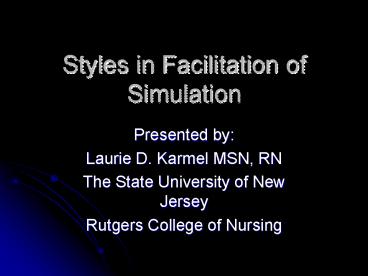Styles in Facilitation of Simulation PowerPoint PPT Presentation
1 / 28
Title: Styles in Facilitation of Simulation
1
Styles in Facilitation of Simulation
- Presented by
- Laurie D. Karmel MSN, RN
- The State University of New Jersey
- Rutgers College of Nursing
2
Disclosure Statement
- The State University of New Jersey, Rutgers, the
College of Nursing in worked in conjunction with
METI to create simulations published in the PNCI
curriculum
3
Introduction
- Know your curriculum
- Identify learning needs
- Flexibility
4
Advantages
- Learning in a risk free environment
- Interactive learning
- Repeated practice of psychomotor skills
- Immediate faculty feedback (prompting)
- Increased exposure to a variety of clinical
events - Teaching moments
5
Disadvantages
- Students may not take it seriously
- Students may aggressively tune into the
possibility that something may suddenly happen
and be overzealous - Faculty buy-in
- Equipment cost and overhead
- Equipment availability
6
Overcoming Disadvantages
- Take me seriously, please
- Create realism
- Scenery (KB Port Backdrops)
- Voice
- Male vs. female
- Outfitting
- Instructor approach
- Equipment availability
- Student preparation
- Self evaluation Students dont know what they
dont know
7
Styles for Facilitation of Simulation and
Decisions Made
- Choosing an appropriate simulation
- Present simulation to meet needs identified
8
The Beginning of Decisions
- Stable vs. altered health status
9
Decisions continued
- States vs. jobs
10
Decisions continued
- Assigning jobs/states vs. student
choice
11
Decisions continued
- Instructor led vs. simulation facilitator led
12
Decisions continued
- When to correct behaviors
- Debriefing
- Evaluation-if a component of course
13
Orientation
- Safe to make mistakes
- Group discussions
- Group decisions
- Not evaluated (if this is the case)
- Used as a learning tool
- Lab interpretations
- Clinical experiences in the RN role that are
difficult to achieve in the clinical hospital
setting - Phone orders
- IVP medications
- Following patient the entire shift
- Communication with other health team members
14
- Encouraged to take job to strengthen their
weaknesses - Receive report
- Find missing information
- Creation of a short term plan
- Begin head to toe assessments
- Some simulations have immediate needs presented
- Some simulations develop problems throughout the
simulated shift - Students identify those problems and prioritize
treatment - Group Learning
- Individual decision making
- Discussion among group
- Use of group as lifeline
- Inclusion of prevention
15
Example 1
- Orientation
- Assign jobs/pick jobs
- State 1
- Out of room for prompts
- State 2
- Out of room for prompts, etc.
- debriefing
16
Benefits/Pitfalls
- Allows for thinking time
- Allows students to self correct behaviors
- Allows for preparation of next state without
students at bedside - mistakes identified without the opportunity to
correct at bedside - Time consuming
17
Example 2
- Orientation
- Assign jobs/pick jobs
- State 1-end, minimal cues
- At end, prompt questions
- debriefing
18
Benefits/Pitfalls
- Flow of simulation is smooth
- Allows students the opportunity of identifying
need for redirection - Corrections made from students, not instructors
- May find that the simulation takes a turn in the
wrong direction - Unsure if student or students in the group will
ever identify assessments missed - May lead to poor morale at debriefing
19
Example 3
- Orientation
- Assign jobs/pick jobs
- State 1 moderate cueing/prompts during states
- debriefing
20
Benefits/Pitfalls
- Assures students going in the direction intended
by immediate redirection - Addresses the learning opportunity at the time
the situation arises - Positive moral at end of simulation
- Lengthens simulation time
- Can lead to spoon-feeding
21
Time management
- Stable vs. altered health status
- Based on needs identified
- State vs. job assignments
- Inclusion of patient teaching and prevention
- Debriefing
22
Junior Objectives
- By the end of this simulated experience, the
student will be able to demonstrate a focused
assessment. - By the end of this simulated experience, the
student will function as a part of a cohesive
team in effort to deliver nursing care to clients
at various levels of wellness. - Deatrah Dubose, RN, CCRN, MSN, APRN-BC and
Laurie Karmel, RN, MSN
23
Senior Objectives
- By the end of this simulated experience, the
student will be independent in his/her effort to
develop and implement a comprehensive plan of
care for clients at various levels of wellness. - By the end of this simulated experience, the
student will be able to appropriately prioritize
care of clients at various levels of wellness. - Deatrah Dubose, RN, CCRN, MSN, APRN-BC and
Laurie Karmel, RN, MSN
24
Terminal Objectives
- By the completion of the simulation program, in
the senior year of the nursing program, the
student will exhibit confidence in his/her
assessment, plan of care, and interventions
provided at various levels of wellness. - By the completion of the simulation program, in
the senior year of the nursing program, the
student will be able to reflect upon their
actions in the delivery of care as a tool for
critical thinking as each student transitions
from a graduate nurse to an experience nurse. - Deatrah Dubose, RN, CCRN, MSN, APRN-BC and
Laurie Karmel, RN, MSN
25
Simulated Experience
26
Debriefing
- Answers students questions
- Sort out and clarify student thinking
- Reinforces specific teaching points
- Refocuses direction of priorities
27
Discussion/ Summary
- Lets chat!
28
- References
- Gaba, D.M.(2006). The future vision of simulation
in health care. Quality and Safety in Health
Care, 13 (Suppl l), i2-i10. - Mort, T.C.,Donahue, S.P. (2004). Debriefing The
basics. In W.F. Dunn (Ed.), Simulators in
critical care and beyond (pp. 76-83). - Van Sell, S., Johnson-Russell, J.,k Kindred, C.
(2006). The teaching power of high-tech dummies.
RN, 69 (4), 30-34.

